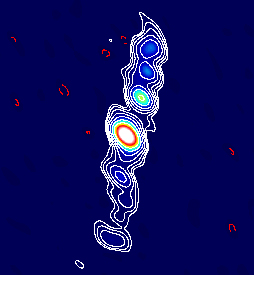

First 512 Mbps e-EVN image from six stations
The observations were made using the Cambridge, Jodrell Bank (MkII), Medicina, Onsala, Torun and Westerbork (phased array) telescopes. The 3-hour observations were carried out in phase-referencing mode, changing between a bright calibrator and a fainter target source every few minutes. Due to microwave link limitations between Cambridge and Jodrell Bank, Cambridge effectively participated at 128 Mbps.
JIVE has been running e-VLBI operationally for over a year. The success with the 512 Mbps experiment
proves the ability to support multiple baselines at high data rates in support of scientific observations.
This capability makes e-VLBI competitive with disk based observations and brings us closer to a fully real
time, network based, VLBI system. By early 2008 we expect that several new EVN stations come online or upgrade
their connection, including the 100m Effelsberg, and the 300m Arecibo telescopes.
About the European VLBI Network (EVN)
About EXPReS
About JIVE
# # #
Contact:
 DWINGELOO, The Netherlands (6 July 2007) - On 26 June 2007, the European VLBI Network (EVN) carried out the first successful six European station e-VLBI (electronic very long baseline interferometry) observations at 512 Mbps data rate. The target was J0000+4054, classified as a compact symmetric object (CSO). CSOs are believed to be young radio sources from the observed small size and proper motions in their radio structure. The attached image of J0000+4054 shows this radio emission elongated roughly in North-South direction with a dynamic range exceeding 1000:1 and a noise level of 200 microJy/beam.
DWINGELOO, The Netherlands (6 July 2007) - On 26 June 2007, the European VLBI Network (EVN) carried out the first successful six European station e-VLBI (electronic very long baseline interferometry) observations at 512 Mbps data rate. The target was J0000+4054, classified as a compact symmetric object (CSO). CSOs are believed to be young radio sources from the observed small size and proper motions in their radio structure. The attached image of J0000+4054 shows this radio emission elongated roughly in North-South direction with a dynamic range exceeding 1000:1 and a noise level of 200 microJy/beam.
The European VLBI Network (EVN, www.evlbi.org)
is an interferometric array of radio telescopes spread throughout
Europe and beyond, which conducts unique, high resolution, radio
astronomical observations of cosmic radio sources. It is the most
sensitive VLBI array in the world, thanks to the collection of
extremely large telescopes that contribute to the network.
Express Production Real-time e-VLBI Service (EXPReS, www.expres-eu.org)
is a three-year project funded by the European Commission with the
objective of creating a distributed, large-scale astronomical
instrument of continental and intercontinental dimensions. This
electronic Very Long Baseline Interferometer (e-VLBI) is achieved using
high-speed communication networks operating in real-time and connecting
together some of the largest and most sensitive radio telescopes on the
planet. EXPReS is coordinated by JIVE, the Joint Institute for VLBI in
Europe (www.jive.nl), which is hosted by ASTRON, the Netherlands Foundation for Research in Astronomy (www.astron.nl), in Dwingeloo.
The Joint Institute for VLBI in Europe (JIVE, www.jive.nl)
was established as a scientific foundation in December 1993. JIVE's
mandate is to support the operations of the European VLBI Network (EVN)
in the widest sense. The major activity has been the development,
construction and successful operation of the EVN Data Processor, a
powerful supercomputer that combines the signals from radio telescopes
located across the planet, creating one huge telescope of
intercontinental dimensions. Using this technique of Very Long Baseline
Interferometry (VLBI), astronomers can make detailed images of cosmic
radio sources, providing astronomers with the clearest, highest
resolution view of some of the most distant and energetic objects in
the Universe.
Arpad Szomoru, Head of Data Processor Research and Development
Express Production Real-time e-VLBI Service (EXPReS)
Joint Institute for VLBI in Europe
+31 521 596 500
szomoru@jive.nl
www.expres-eu.org